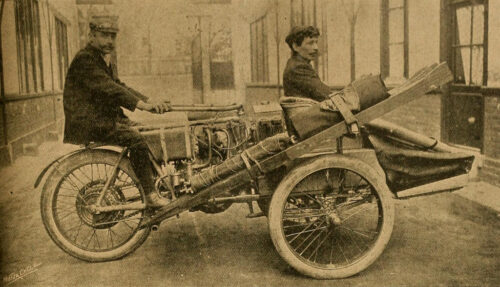
They say that the car gives an indescribable sense of freedom. Whether it’s midnight or six in the morning, you can always get into your car and drive wherever you look. But, do you have the courage to go on a multi-day trip from Asia to Europe in a car that is several decades old and instead of the usual navigator you will have a navigator with a road book? Only few in the modern world are capable of such madness, but what can we say about the distant 1907, when the legendary rally «Peking to Paris» appeared. An event that has become a «legend alive» — in our weekly namesake column.
In 1907, the Le Motin newspaper published the following, “It is necessary to prove that as long as a person has a car, he can do anything and get anywhere. Will anyone dare to travel from Beijing to Paris by car this summer? It is unlikely that journalists could think that there would be daredevils who dare to go on an extreme journey from China to Paris, but there were quite a few of them.
40 people responded to Le Motin’s call to test themselves for strength, but only five crews left for the start on June 10, 1907 in Beijing, four of which will finish in Paris two months later, and a thriller can be shot about the trip of Auguste Pons who had descended. But first things first.
So, five crews, representing Italy, France and the Netherlands, hit the road. The most powerful car was the bright red Itala, powered by a 7.4 liter four-cylinder engine, driven by Prince Shipione Borghese. In short, he had every chance to win a 1.5 liter bottle of Mumm champagne, he just had to get to the capital of France.
In fact, getting to Paris was not as easy as it might seem at first glance. To begin with, the first car with an internal combustion engine was created only in 1885 by Karl Benz, and until 1907 it never occurred to anyone to get from Beijing to Paris, and, secondly, the crews did not have maps. Telegraph poles were the main reference point along the way. Thus, the award in the form of that very bottle of champagne could cost the participants their lives. Whether they were embarrassed by the prospect of being lost and not returning home, we will never know, but the courage of these people can be envied in a good way.
Having left Beijing for Paris, the participants could hope for good luck and that their «iron horses» would not suddenly break somewhere far from civilization. But hope is a capricious lady, and someone must have been unlucky. That loser was Auguste Pons. His three-wheeled friend Contal Mototri broke down in the Gobi Desert. If not for the help of the nomads who met on the way, then, most likely, he would have stayed somewhere close to his «horse» together with Octave Foucault, and we would not have read the letter in the newspaper La Vie au Grand Air, filled with tragic details of his stay in the sands of the third largest desert in the world.
At the same time, while Pons was wandering in the desert with Foucault, Borghese deviated from the course, visited St. Petersburg and returned to the race through Moscow. The Italian not only had a good time, but also did not lose his advantage, reaching the finish line in Paris first. A year after the victory, Shipione published the book From Beijing to Paris, where he spoke in detail about his unforgettable adventure behind the wheel of an Itala 35/45 HP in the company of Ettore Gwizzardi and journalist Luigi Barzini Sr. (each car included a journalist who transmitted the news via telegraph stations located along the rally route — editor’s note). It is worth noting that if you have a desire to see the Borghese car with your own eyes, then welcome to the Automobile Museum in Turin. Despite its venerable age, Itala is still on the go!
And what happened to the three crews who made it to the finish line with Borghese, you might ask. Charles Godart and Jean du Thilis finished second, but Godart was arrested for fraud. He had no money for gas and borrowed a Spyker to race. Georges Cormier from France finished third onboard a DeDion. Behind him, Victor Collignon saw his home soil in a car of the same brand.
It is unlikely that Borghese, and even more so Pons, could have imagined that tens of years later, daredevils from different parts of the world would repeat their route, but instead of telegraph poles, they would have travel books and the ability to call for help so as not to be trapped from which to get out it will be possible only on foot or by accidentally meeting a nomad. But time passes, but traditions do not change and the desire to test themselves for strength pushes people to crazy actions, such as participation in the rally «Peking to Paris».